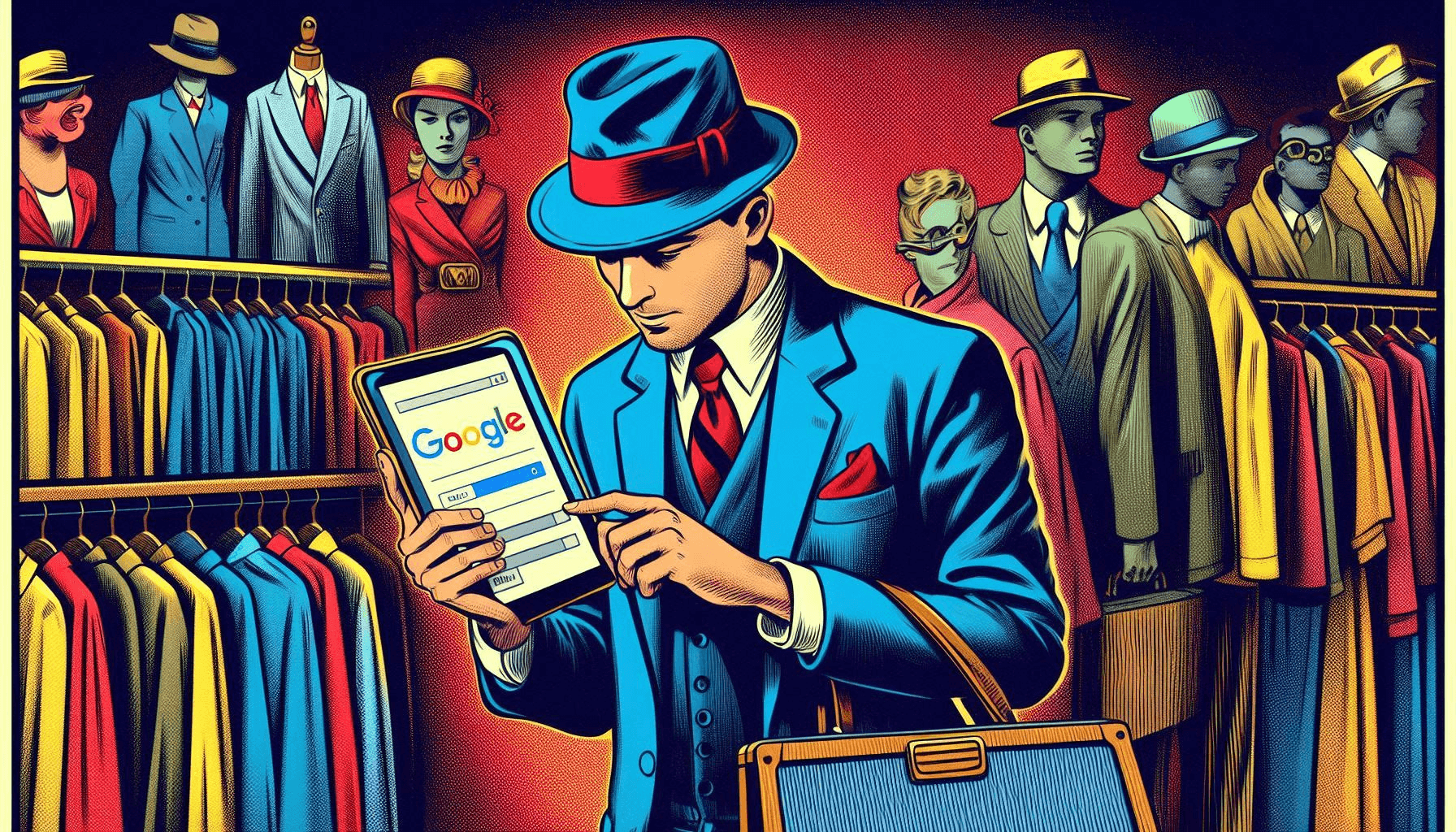You will turn 80% of your visitors into buyers if you offer them personalized experiences using Google Ads and other social media ads.
But this is not easy to implement at scale without draining all your time and resources.
This is where dynamic creative optimization (DCO) comes into play.
If you are tired of generic ads that fail to convert, this article is your roadmap to mastering DCO. We will discuss what it is, how it works, and how you can implement it to enhance your advertising strategies.
Let’s get started.
What Is Dynamic Creative Optimization (DCO) & How Does It Work?
Dynamic creative optimization (DCO) is a display ad technology that uses real-time data to tailor ad content for individual users. It helps you serve the right ad to the right person at the right time.
Unlike traditional static ads, which are the same for everyone, dynamic creative optimization automatically changes elements like images, text, and calls to action (CTA) based on the viewer’s data, like browsing history, location, and device.
Here is the 3-step process of any dynamic creative optimization process:
- Data Collection: DCO pulls data from various sources like your website, CRM, or browsing history.
- Creative Assembly: The system assembles ad components like images and headlines based on this data.
- Real-Time Delivery: It serves ads dynamically that adjust in real-time to be as relevant as possible for the user.
For example, assume you own a footwear brand and a customer recently viewed running shoes on your website. If you are using DCO ads, your retargeting ad will display the exact shoes they viewed with a personalized discount offer. This will increase the chances of a conversion.
These ads are 93% more efficient than static ads and give you the following 6 benefits:
- Effective Retargeting: It helps you re-engage your customers with personalized ads based on their previous interactions and effectively drives them back to your site.
- Cost-Effective: You automate the creative process and optimize your ads based on real-time performance. This minimizes wasted ad spend.
- Fully Automated: You free up your team to focus on strategy because the entire ad-optimization process is automated.
- Hyper-Relevant Ad Content: All ad components like images, texts, and offers are customized to align with the user’s preferences. This makes your ads far more engaging than traditional static ads.
- Continuous Data Integration & Broad Reach: It pulls data from multiple sources and your creative management platform. This means you can reach customers wherever they are with consistent, personalized messaging.
- Creative Precision & Versatility: DCO campaigns show your customers the most effective elements through static image or video ads.
2 Levels Of Dynamic Creative Optimization
Review your ad creation process to pick which one you can use to enhance your ad campaign performance.
A. Static Units
Static DCO includes pre-made ad templates where an algorithm selects which creative elements to display. The template doesn’t change, but the dynamic content within the ad, like images or text, adjusts based on user data.
For example, if you own an airline, you may use the same ad template to display different destinations based on your user’s location. You may display flights to Paris to your customers in New York and show Tokyo flights to those in LA.
B. Dynamic Units
Dynamic DCO selects creative elements and optimizes them in real-time based on performance. The DCO system continuously learns and improves to deliver the highest-performing combination of creative elements for each individual.
For example, if you own a clothing store, you may display dynamic ads highlighting different outfits based on your customer’s location and the weather conditions there. Your dynamic ads will display t-shirts for sunny climates and warm coats for cold weather.
6 Innovative Dynamic Creative Optimization Strategies (+ Examples)
Review your current ads to see where they are falling short and pick 1-2 of the following strategies to optimize your creative performance.
1. Test Different Times Of The Day To Find The Right Time To Reach Your Audience
You will likely experience a peak in customer engagement on social media between 9 am and 2 pm from Tuesday to Thursday.
This window will vary based on your industry and audience. So, use DCO to test different times of the day and adjust your ad delivery for peak engagement. This will maximize your ad spend and increase clickthrough rates (CTR).
Do this:
- Identify your peak engagement hours by analyzing your audience’s activity throughout the day with Google Analytics 4 or any other customer data management platform. Use clickthrough rates and engagement to pinpoint when exactly your audience is most active.
- Use AdRoll or Criteo’s to dynamically adjust ad delivery based on real-time data about your audience’s behavior. These tools will automatically push ads during peak engagement hours to increase customer engagement.
- Assess times that lead to the most conversions with time-specific performance metrics and allocate more of your ad budget to this time block moving forward.
- Adjust your messaging based on time and tailor your ad messaging to reflect the time of day. For example, “start your morning right” for morning ads and “unwind after work” for evening ads.
- Set up automated A/B testing for different times with Google Ads or Meta Ads Manager and schedule your ads to run at different times of the day to test performance across time zones or target markets.
This is especially useful for health and wellness eCommerce businesses like Green Supply, where timing is everything. Customers looking for wellness products like supplements often search during specific times of day when they are most concerned about their health, like early morning or late evening when they focus on personal wellness routines.
You can test different times of day to target customers with ads for products like KN95 masks from Green Supply. This will make sure your ads reach the right customers at a time they are most likely to engage.
For example, if your audience is more active in the evening, you can schedule ads that focus on relaxation products to align with their end-of-day routines.
2. Experiment With Weekly Promotions To Find What Works For Different Offers
46% of your customers need personalized communications to build trust.
So, use DCO to test various weekly promotions and automatically adjust your ads based on which offers perform best for each customer segment. This will capture the right audience’s attention, encourage repeat visits to your website, and convert users at different stages of the sales funnel.
Here is what you need to do:
- Segment your email lists and use email marketing to drive different weekly offers and target different groups, like new subscribers and high-value customers, with varying promotions. Analyze email open rates and clickthrough rates for each promotion to find groups that make the most purchases.
- Use your customer’s purchase history or preferences to personalize your weekly offers based on individual customer data. For example, send them a personalized email with a buy one, get one free offer on products similar to what they previously purchased.
- Predict future promotions based on past weekly promotion performance and adjust your campaigns accordingly. For example, if free shipping converts 20% more customers compared to discount offers, focus your next promotion on shipping perks instead of percentage discounts.
- Schedule and coordinate weekly promotions across social media, email, and display ads to maintain consistency across all touchpoints.
- Run multiple versions of your weekly promotions with Unbounce or Optimizely using distinct offers, like percentage off, free shipping, or buy one, get one free.
This is very important for brands that sell luxury items to high-ticket customers like Whole Wood Playhouses. Customers in this niche often need time to consider purchases and might be waiting for the right promotion or discount to convert.
So, you can experiment with weekly promotions and test various offers, like percentage discounts or free delivery, to see what resonates best with your audience and encourages them to buy.
3. Automatically Update Milestone Event Ads For Relevant Ad Experience
42% of your customers feel excited when they see banner ads with a countdown to a date.
You can display ads to reflect milestone events like birthdays, anniversaries, or subscription renewals with DCO campaigns. Consequently, you will reach your customers at key points in their journey and make them feel valued.
Here’s what you need to do:
- Use data triggers like birthdays, anniversaries, or upcoming events to update milestone event ads automatically. Set up workflows to trigger event-specific promotions and create personalized messages based on specific events.
- Connect your calendar APIs to update your ads for holidays, local events, or customer milestones in real-time based on your customer’s location.
- Identify key customer milestones with Salesforce or HubSpot and create milestone-based offers for your ads targeting high-value customers. For example, you can send a personalized 20% off ad for a customer’s 1st anniversary with your brand.
- Send different ads for those celebrating their 1st versus their 5th anniversary as a customer and segment your milestone ads by individual customer behavior. Customers celebrating a longer-term relationship should receive a more generous discount or exclusive offer.
- Create eye-catching dynamic ad creatives that are visually engaging for milestone ads using Canva, Adobe Express, or any other creative management platforms. Make sure your ads reflect the significance of your milestone, and add personalized messaging accordingly.
This strategy is perfect for online education and e-learning platforms like Classical Guitar Shed that need to nurture students at different stages of their learning journey.
You can automatically update ads for milestones like course completions, upcoming lessons, or subscription renewals to keep your students engaged and encourage them to stay on track with their learning for a longer term.
4. Customize Ad Content Based On Location To Encourage Purchases
88% of your local customers who search for your business on mobile will call or visit your store within 24 hours.
You can customize your ads for these customers and create separate ads for others based on their geographic location. This hyper-relevant content speaks directly to local preferences and drives in-store visits.
Here’s what you should do:
- Use geotargeting to deliver relevant ads and adjust your ad content based on location to highlight local events, weather, or store availability. Promote city-specific deals and emphasize limited-time offers in nearby locations.
- Use Google Analytics 4 to gather insights about where your site traffic comes from and tailor your ads to different regions based on customer behavior and preferences.
- Highlight your customer’s proximity to physical stores in ads. Use Google Maps integration in your ads to show customers how close they are to your nearest store and encourage them to visit.
- Use a dynamic ad platform to serve ads that feature products or services popular in a specific region or city. For example, target colder cities like Chicago or Boston with apparel choices like winter coats with specific messaging on staying warm.
- Segment your audience based on location and tailor your messaging to target specific cities or regions more effectively. For example, highlight free shipping for rural audiences and fast shipping options for customers in urban locations.
Travel, events, or retail businesses that heavily rely on location-based marketing can enhance this strategy with localized product promotions. Combine this strategy with the 12 promotional product trends to create customized and relevant merchandise that resonates with specific regional audiences. This will drive both engagement and conversions.
5. Use Your Browser’s Language To Connect With Them More Meaningfully
76% of your customers prefer to buy products with information in their native language.
Use DCO strategies to adjust your ad content’s language automatically to match your customer’s browser settings. This increases customer engagement, increases clickthrough rates, and strengthens your connection with your customers.
Here’s how you can do this:
- Create language-specific content and visuals that reflect the cultural nuances and language preferences of your audiences.
- Research cultural trends and language preferences in different regions and align your ad copy with cultural context. Make sure your ad creatives and messaging match the local context. Use local slang, traditions, and humor, and avoid direct translations.
- Create customized CTA buttons in different languages to make sure your ads are fully localized for better engagement. This can have a stronger impact on non-English-speaking customers.
- Create language-based audience segments for email marketing campaigns and send language-specific offers to your segmented email lists.
- Use Google Ads’ language settings to display ads in your audience’s preferred language. Make sure that your landing pages and other dynamic creatives in the entire user journey are also available in the same language to be consistent.
If you have international customers, tailor your content to match your target audience’s browser language. This will make the content more accessible and enhance user trust and engagement. Plus, you can pair this approach with the top 8 strategies to make your social media page stand out.
These two coupled together will make sure your brand speaks to your local audiences in a language and style they connect with.
6. Adapt Your Ad Copy Based On Current Weather To Increase Relevance
You can increase your sales by 600% with weather-related advertising.
Use DCO campaigns to achieve these results. For example, you can adjust your ad copy and imagery to reflect your customer’s current weather conditions and resonate with their immediate environment. These ads automatically feel more relevant and timely and increase interactions and sales.
Do the following:
- Use real-time weather data to trigger ad updates and integrate them into your ads directly. Adjust your product offerings based on the weather conditions in the user’s location. For example, display ads for raincoats when it’s raining or sunglasses when it’s sunny in your customer’s region.
- Create weather-based dynamic ads that change based on local weather. Test different weather conditions to see how your ad performance varies.
- Tailor your messaging based on temperature and customize ad copy for different temperature ranges. Use language that aligns with how your customers feel based on local weather. For example, use copy like “Stay cozy with our winter collection” to resonate more deeply with customers in colder regions.
- Create and promote weather-specific product bundles that appear in ads when triggered by specific weather conditions. For example, you can bundle rain boots, umbrellas, and jackets for the rainy season.
- Use location-based weather forecasting tools to forecast local weather and adjust your ads in advance. Make sure you schedule your campaigns ahead of predicted weather changes. For example, if LA is expecting a heatwave, schedule ads for sunscreen and swimwear just before the weekend.
Since this requires a deep understanding of advertising strategies and technical tools, hire a seasoned advertising executive for this strategy. This requires someone who can precisely coordinate across platforms, integrate data, and execute your campaigns creatively.
A good advertising executive can help you resonate with your audience and perfectly time your campaigns for maximum impact.
3 Steps To Follow For Dynamic Creative Optimization
Review your current creative strategy and use the following to break it down into manageable steps.
Step 1: Use High-Quality Data To Create Your Buyer Personas & Select Your Digital Channels
Accurate, high-quality data is the backbone of successful DCO campaigns. Create detailed buyer personas to target your audiences with personalized ads that speak directly to their needs.
Here’s what to do:
- Gather demographic and behavior data for your target audience.
- Create detailed buyer personas and specify age, job, location, interests, and pain points.
- Identify where your audiences spend time online and tailor your DCO campaigns accordingly.
- Update your personas every quarter based on user interaction data.
- Track user behavior on your site and refine your personas based on actual browsing habits.
Step 2: Create Multiple Messages & Ad Elements
This will help you stay consistent across various platforms, customer types, and buyer’s journey.
Do the following:
- Create multiple versions of your ad creatives, like product images, backgrounds, and layouts.
- Write different combinations of ad copy variations for each buyer persona so your messaging is clear and engaging.
- Use a dynamic creative optimization platform to set up dynamic ad components, like headlines, CTAs, and offers, that can adjust automatically based on user behavior.
- Use Google Ads Responsive Display Ads to create dynamic ad components that rearrange based on performance.
- Test multiple ad formats, like static, carousel, and video, to see which resonates most with different audiences.
- Refresh your creative assets every quarter to make sure they are relevant to your audience’s preferences.
Step 3: Monitor Performance & Optimize Campaigns
This last step will help you make data-driven optimizations to improve engagement and increase your conversion rate.
Do this:
- Track key metrics like clickthrough rates, bounce rates, and conversion rates for your DCO campaign.
- Automatically optimize your campaigns based on which creatives are performing best.
- Find out which combinations of your dynamic ad elements are delivering the highest ROI and which ad performs best for different audiences.
- A/B test new creative elements as your campaign progresses to keep your ads fresh and engaging.
- Review your performance data monthly and use insights to inform future DCO campaigns for continuous improvement.
Conclusion
Are you ready to create ads that stand out in today’s crowded digital space?
Start with 1 or 2 of the strategies we discussed, like testing different times of the day for your ads or setting up milestone event triggers. As your campaigns grow, you can expand into more complex, dynamic ad optimization.
99Robots can help you master DCO with automated tools and expert guidance to drive higher engagement and better results faster. Contact us for a free consultation today and start building personalized, high-converting ad campaigns.






